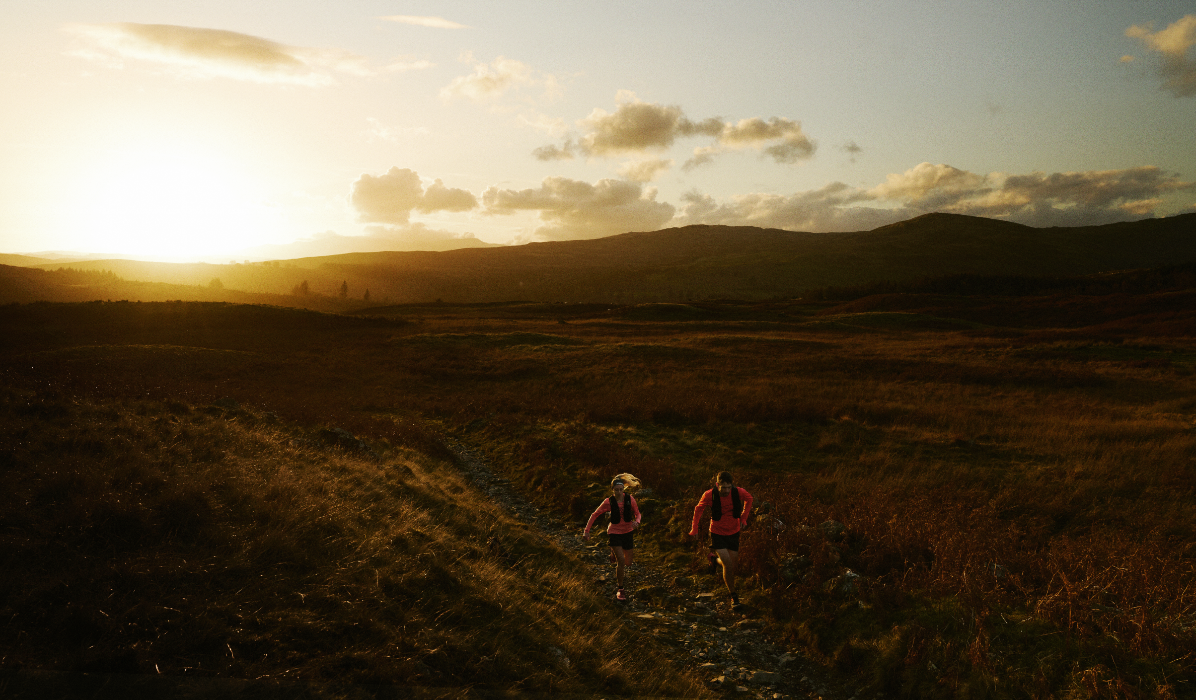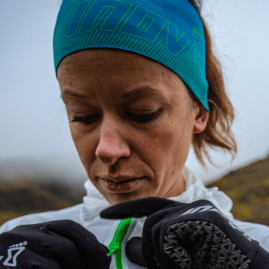
Trail marathons offer a completely different experience to big city events that are run on road. Expect beautiful landscapes, hilly courses, challenging terrain and a funny walk for a few days afterwards!
Training for a trail marathon differs to training for a road marathon too. While the core sessions such as the weekly long run are the same, they will be more focused around the conditions you’ll be racing in. Some road/path running is ok, but there’s no substitute to running off-road in preparation for your event.
We’ve asked international athlete and running coach Sarah McCormack to write a training plan for a trail marathon. Sarah’s 16-week plan is perfect for road runners wanting to transition to their first trail marathon event, as well as those running the marathon distance for the first time.
We hope you enjoy the plan and would love to hear how you get on!
BEFORE YOU START
A marathon is a big undertaking, and something that needs to be built up to. If you’re new to running, you might be better tackling a shorter distance such as a half marathon or 10k first.
Sarah’s training plan is based on someone who is already running five or six days a week, accumulating an average weekly mileage of at least 30-40 miles. However, the plan can easily be modified to five days of running per week by skipping the Saturday or Thursday easy runs.
Sudden jumps in mileage, speedwork or elevation are a recipe for sore legs and injury. If week one would be too much of a stretch for you from where you currently are, consider:
Substituting the Saturday or Thursday easy run and/or one of the hard sessions for rest days.
Substituting one of the hard sessions for an easy run for a few weeks. Then gradually increase the speedwork over a number of weeks (particularly if you currently only do one hard session per week). If you drop one of the hard sessions, be sure to alternate the type of workout (don’t miss all the hill, tempo or fartlek sessions).
If you do drop down to one speed session per week, you can move the Tuesday session to later in the week. You might find this particularly beneficial if you’re fatigued after your Sunday long run.
It’s critical to establish a training pattern that works for you. A training pattern defines the days of the week that you tend to do certain types of run.
In the plan we have hard sessions on Tuesday and Friday, and then the long run on Sunday. However, there’s no reason you couldn’t move the sessions around to make the plan fit in better with your lifestyle. One word of caution here though – make sure you include adequate rest/easy days between your harder runs!
SARAH MCCORMACK’S 16-WEEK TRAIL MARATHON TRAINING PROGRAM
Be sure to read the training plan guidelines in conjunction with this program, as it explains the sessions in more depth. It’s also worth reading the section on working out your effort levels too, particularly where the plan talks about 1h, 2h and 3h race pace.
| Week | Mon | Tue | Wed | Thu | Fri | Sat | Sun |
1 | Rest | Fartlek: 4 x 4 min fast tempo with 2 min easy jog recovery. Aim 1h race pace (90 % effort) for your reps | 6 miles - easy | Rest or 5 miles - easy | Tempo run: 15 min at 2-hour race pace (75-80% effort) | Rest or 5 miles - easy | 8 miles long run with 30% of the climb you will do in your race |
| 2 | Rest | Fartlek: 6-4-4-6 min fast with 2 min easy jog recovery. Aim for 1h race pace (90 % effort) for your reps | 5 miles - easy | Rest or 5 miles - easy | Tempo run: 20 min at 2-hour race pace (75-80% effort) | Rest or 5 miles - easy | 9 mile long run with 30% of the climb you will do in your race |
| 3 | Rest | Hill reps: 4 x 2.5 minutes hard uphill with easy jog recovery back to your starting point. Aim for fastest sustainable pace & consistent pacing between reps | 6 miles - easy | Rest or 4 miles - easy | Fartlek: 6-4-2-2-4-6 min fast with 2 min easy jog recovery. Aim for 1h race pace (90 % effort) for your reps | Rest or 5 miles - easy | 10 mile long run with 35% of the climb you will do in your race |
| 4 | Rest | Fartlek: 6 x 4 min fast tempo with 2 min easy jog recovery. Aim 1h race pace (90 % effort) for your reps | 5 miles - easy | Rest or 4 miles - easy | Hill reps: 5 x 2.5 minutes hard uphill with easy jog recovery back to your starting point. Aim for fastest sustainable pace & consistent pacing between reps | Rest or 4 miles - easy | 11 mile long run with 40% of the climb you will do in your race |
| 5 | Rest | Hill fartlek (20 mins): Using an undulating route, run all uphills at a hard intensity, and all flats & descents at easy recovery pace. Your pace on the climbs can vary between 20-min race pace for very short climbs, up to 90-min race pace for longer ascents | 4 miles - easy | Rest or 4 miles - easy | *Tempo run: 2 x 12 min at 2-hour race pace (75-80 % effort) with 3 min easy jog recovery between the two reps | Rest or 4 miles - easy | 13 mile long run with 30% of the climb you will do in your race |
| 6 | Rest | 20-min progression run: 10 mins of running @ 2h race pace (75-80 % effort) followed immediately by 10 mins at 1h race pace (90-95 % effort) | 6 miles - easy | Rest or 6 miles - easy | Easy 4 mile including 6 x 20s strides, with 2-3 mins easy running in between each 20s acceleration | Rest or 5 miles - easy | 9 mile long run with 40% of the climb you will do in your race. In the last 10-15 mins, include 5 x 30s surges (no quicker than 10k race pace), with 2-3 mins easy jog between each effort. Do these surges on a firm, flat section of trail |
| 7 | Rest | Fartlek: 8-4-6-4-4 min fast with 2 min easy jog recovery between reps. Aim for 1h race pace (90 % effort) for your reps | 5 miles - easy | Rest or 4 miles - easy | *Tempo run: 2 x 15 min at 2-hour race pace (75-80 % effort) with 3 min easy jog recovery | Rest or 3 miles - easy | 15 mile long run with 50% of the climb you will do in your race |
| 8 | Rest | Hill fartlek (25 mins): Using an undulating route, run all uphills at a hard intensity, and all flats & descents at easy recovery pace. Your pace on the climbs can vary between 20-min race pace for very short climbs, up to 90-min race pace for longer ascents | 7 miles - easy | Rest or 4 miles - easy | Easy 6 mile including 6 x 20s strides, with 2-3 mins easy running in between each 20s acceleration | Rest or 4 miles - easy | 12 mile long run with 40% of the climb you will do in your race. In the last 3 miles of this run, include 10 mins running at 2-hour race pace (75-80 % effort) |
| 9 | Rest | Tempo run: On undulating trail, run at 1h race pace for 20 mins (this will feel like a hard 90-95 % effort) | 7 miles - easy | Rest or 5 miles - easy | *25-min progression run: 10 mins of running @ 3h race pace (65-70% effort), followed immediately by 10 mins of running @ 2h race pace (75-80 % effort), followed immediately by 5 mins at 1h race pace (90-95 % effort) | Rest or 3 miles - easy | 17 mile long run with 65% of the climb you will do in your race |
| 10 | Rest | Hill reps: 4 x 4 minutes hard uphill with easy jog recovery back to your starting point. Aim for fastest sustainable pace & consistent pacing between reps | 7 miles - easy | Rest or 5 miles - easy | Easy 4 mile including 6 x 20s strides, with 2-3 mins easy running in between each 20s acceleration | Rest or 5 miles - easy | *10 mile long run with 30% of the climb you will do in your race. In this run, include 3 x 10 mins @ 2h race pace (75-80 % effort) with 5 min easy jog recovery between reps |
| 11 | Rest | Fartlek: 3 x 10 min fast with 3 min easy jog between reps. Aim for 1h race pace (90 % effort) for your reps. Move to Weds if still a bit fatigued from Sunday | 5 miles - easy | Rest or 5 miles - easy | Easy 4 mile including 6 x 20s strides, with 2-3 mins easy running in between each 20s acceleration | Rest or 3 miles - easy | 20 mile long run with 70% of the climb you will do in your race |
| 12 | Rest | *30-min progression run: 10 mins of running @ 3h race pace (65-70 % effort), followed immediately by 10 mins of running @ 2h race pace (75-80 % effort), followed immediately by 10 mins at 1h race pace (90-95 % effort) | 6 miles - easy | Rest or 4 miles - easy | Easy 6 mile including 6 x 20s strides, with 2-3 mins easy running in between each 20s acceleration | Rest or 5 miles - easy | *10 mile long run with 20% of the climb you will do in your race. In this run, include 3 x 15 mins @ 3h race pace (65-70% effort) with 5 min easy jog recovery between reps. Alternate to Sunday long run: do a trail 10 mile or half marathon race |
| 13 | Rest | Hill fartlek (30 mins): Using an undulating route, run all uphills at a hard intensity, and all flats & descents at easy recovery pace. Your pace on the climbs can vary between 20-min race pace for very short climbs, up to 90-min race pace for longer ascents | 4 miles - easy | Rest or 4 miles - easy | *Steady tempo: 40 min at 3-hour race pace (65-75 % effort) | Rest or 3 miles - easy | 18 mile long run with 75% of the climb you will do in your race |
| 14 | Rest | Hill reps: 5 x 4 minutes hard uphill with easy jog recovery back to your starting point. Aim for fastest sustainable pace & consistent pacing between reps | 7 miles - easy | Rest or 5 miles - easy | Easy 4 mile including 6 x 20s strides, with 2-3 mins easy running in between each 20s acceleration | Rest or 4 miles - easy | *14 mile long run with 50% of the climb you will do in your race. In this run, include 2 x 20 mins @ 3h race pace (65-70% effort) with 5 min easy jog recovery between reps |
| 15 | Rest | *30-min progression run: 20 mins of running @ 3h race pace (65-70 % effort), followed immediately by 10 mins at 1h race pace (90-95 % effort) | 5 miles - easy | Rest or 4 miles - easy | Fartlek: 4 x 4 min fast tempo with 2 min easy jog recovery. Aim for 1h race pace (90 % effort) for your reps | Rest or 4 miles - easy | 7 mile long run with 20% of the climb you will do in your race |
| 16 | Rest | 10 mins steady @ 3-hour race pce (65-70% effort) | 4 miles - easy | Rest | Easy 3 miles including 6 x 20s strides at a quick but not strenuous pace, with 2-3 mins easy running in between each 20s acceleration | Rest or 2 miles - easy | Race |
*Runs marked in bold are good opportunities to test your race day fuelling strategy.


ABOUT SARAH
Sarah McCormack is an athlete, running coach and INOV8 ambassador. Based in Cumbria, Sarah is an accomplished trail, cross country and mountain runner. Her victories include:
- Irish Cross-Country Champion (2014)
- 3x winner of the Snowdon International Mountain Race (2014, 2015 and 2019)
- Mountain Running World Cup Winner (2019)
Sarah uses her wide-ranging running experience to coach and develop other athletes, designing individual training plans to help them achieve their goals. Visit her website, Missing Link Coaching, for more information.
TRAINING PLAN GUIDELINES
For structured sessions, warm up for 10-15 minutes before (including 4 x 10s strides) and warm down for 10-15 minutes after. Structured sessions are tempo runs, fartleks, hill reps, progression runs, and runs with surges.
Fartleks
Aim for a hard 90% effort for your reps - but not flat out (90% effort is approximately your one-hour race pace). Your fartleks can be done on firm, rolling trail, or on grass in a park.
Surges and strides
These are not sprints! They are fast 10-30 second accelerations that are great in a warm-up for a session/race, or as a way of including a little bit of leg speed training at the end of your easy run. They should be nice and quick, but not flat-out sprints. Aim around 80-90 % of your top speed, so you get the benefits of spinning the legs quickly without any fatigue or muscle soreness.
Tempo runs
Most of these should be done at a moderate 75-80% effort, roughly the pace that you could sustain for a two-hour race. However, for some sessions you’ll be running at 65-75% effort, which is approximately three-hour race pace.
Hill reps
You should run these reps at your fastest sustainable pace (but aim for consistent pacing).
If you only have a small hill to work with, it’s fine to improvise. You could:
- Run back down again when you reach the top, then go up again, until you accumulate the total amount of uphill running time.
- Start with a flat run into your hill. For instance, if the plan specifies a 4-min uphill rep, but you only have a 2-min hill, you’d run 2 mins hard on the flat then straight into 2 mins hard uphill.
- Use a treadmill with an incline function.
When running hills, you should aim to work on your technique too. Our blog “10 Essential Tips For Running Up And Down Hills” is packed with useful information to help you make short work of challenging climbs and technical descents.
Training terrain
Training on terrain that mimics the route you’ll be racing on can really help, particularly for your easy and long runs. However, don’t make big changes to the amount of weekly elevation that you’re accumulating.
Long runs
Trail marathons are typically quite hilly. The long runs in the training plan are designed to prepare you for this come race day. Each long run has a percentage of the race-day climb that you should aim to do. For example, if your trail marathon has 1,000 metres of ascent, and your long run says you need to run 30% of that climb, you should incorporate 300 metres of climb into your route.
Hiking is an important part of racing on steeper terrain! It’s fine to include hiking on steeper sections of trail, particularly when it feels more efficient to walk than to run uphill.
WORKING OUT YOUR EFFORT LEVELS
Understanding your effort level is a key skill in being able to pace and execute a successful trail marathon. Gauging your effort levels during your fartlek, tempo and progression runs will help you get a really good sense of pacing... even if it takes a little bit of trial and error!
1-hour race pace
Feels like a controlled hard effort, but not working quite at your limit. The pace will feel difficult to sustain and you'll be looking forward to the rep being over!- You should only be able to say a few words at a time.
- Maintaining this pace will feel like you are working at 90 % effort, closer to 95 % towards the end of the session.
2-hour race pace
- Feels like a moderately hard effort, but that you’re keeping something in reserve.
- You might be able to say 1-2 sentences at a time, but will have to pause between words frequently to breathe.
- Maintaining this pace will feel like you are working at 80 % effort, closer to 85 % by the end of the session.
3-hour race pace
- Feels like a fairly fun, cruising effort… at least for durations of 20 mins or less!
- You should feel like you’re keeping plenty in reserve and able to say multiple sentences without too much difficulty.
- After the first 15-20 mins of running at this pace, an element of fatigue will start to creep in. However, this should be a gradual process, and your main feeling should be one of moving economically and with only moderate effort.
- Finish these tempo runs with plenty left in the tank.
- Maintaining this pace will feel like you are working at 65-70 % effort, closer to 75 % by the end of the session.
Easy runs
- By contrast, easy runs should be very relaxed and within your comfort zone.
- You should be able to have a full conversation and not need to pause for breath in the middle of a sentence.
- If you’re running in hilly terrain, it may be necessary to incorporate some hiking on the steep sections, to ensure that your effort level doesn't shoot up.
- In general, easy runs should feel like 30-40 % effort.
FUELLING DURING SESSIONS & RACES
It’s important to practice fuelling during your more marathon-specific training runs, so that you can work out a fuelling strategy for race day. In general, 60g carbohydrate/hour is a good minimum intake rate to aim for, though fuelling requirements vary on an individual basis and may take a bit of trial and error.
In the training plan, the runs marked in bold font offer a good opportunity to test out your race-day fuelling strategy.
Where this run is only an hour long (including warm up and warm down), this might be as simple as bringing a couple of gels and a drink. For Sunday long runs, this may require bringing a number of snacks such as gels, chews, or carbohydrate mixed into your drink, in order to achieve at least 60g carb/hour for the full duration of your run.
It’s also a good idea to test out your pre-race breakfast before the long runs that include faster running. For Sunday long runs where full race-day fuelling is not suggested, it’s still a good idea to bring a drink and some snacks.
If you’re looking for some further inspiration, check out our blog “Top 10 Trail Running Superfoods”.
PREPARATION RACES
It can be beneficial to mix in one or two races in the lead-up to the marathon. Sarah’s plan suggests that week 12 might be a good time to swap in a 10-mile or half-marathon trail race instead of the Sunday long run, but this could be included on any weekend from week 9-13.
A trail 10k race could also be included earlier in the plan. These races are useful opportunities to test out your race-day routine, shoes, kit, pacing, fuelling, etc, before the main event.
STRENGTH TRAINING FOR YOUR MARATHON
Strength and conditioning work will make you stronger and less prone to injury. Try to incorporate 1-2 sessions a week.
If you can, try to start your strength work a few weeks before you start your trail marathon plan. It’s likely that you’ll be sore the first few times after your session, so by starting it early you reduce the chance of that soreness impacting your running sessions.
Whether you choose to do your strength work on your hard or easy running days is up to you – but avoid doing it on your rest days.
If you need inspiration for your strength workout, check out these articles on strength training from record-breaking ultrarunner Damian Hall:


TRAIL MARATHON KIT LIST
Unlike shorter trail events, it’s likely that you’ll have to carry some mandatory kit/fuel in your trail marathon. Kit lists will vary by event and can often change close to race day (as the likely weather conditions become apparent).
Common mandatory trail marathon kit lists include:
- Waterproof jacket (and possibly waterproof trousers too depending on the conditions)
- Hat
- Gloves
- Drinks
- Food
- Mobile phone
- Course map (usually provided by the race organiser)
- To carry all that you’ll want to consider a hydration vest with ample storage (a waist pack may not be enough, particularly if you’re required to carry liquid with you).
SOME GREAT TRAIL MARATHONS TO TRY
Not decided on an event? There are so many great trail marathons to try. Here are a couple of our favourites:
Lakeland Trails Marathon, Lake District
Usually in June. The Lakeland Trails marathon takes in a complete circuit of Coniston Water. A beautiful, challenging course with nearly 1,100 metres of ascent and descent.
Pennine Trail Marathon, Burnley
Usually in August. A hilly marathon with a fast downhill finish. Tackle 1,200 metres of climb across four big climbs along the route.
